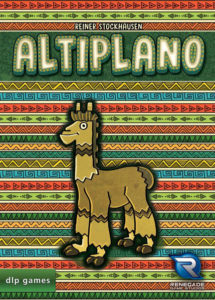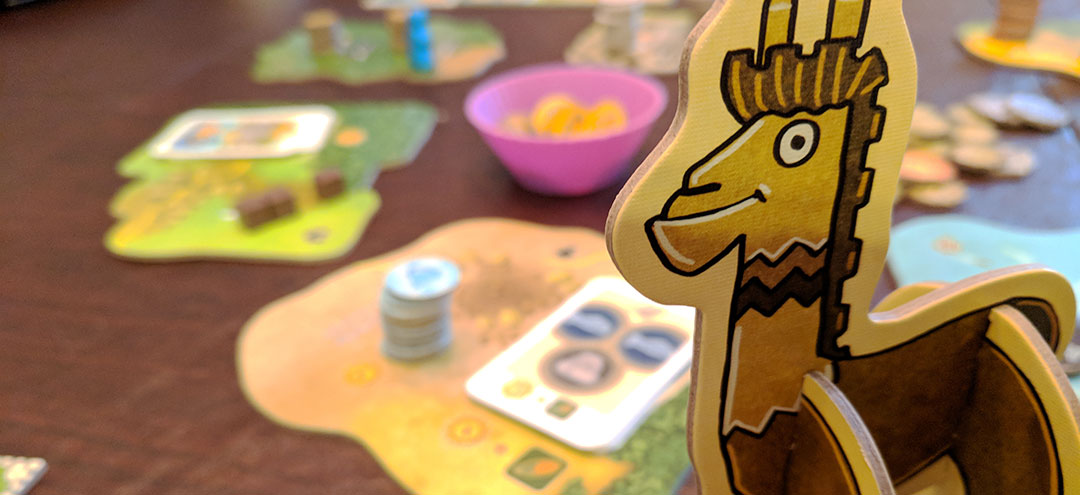 Reiner Stockhausen’s Orleans quickly became one of my favorites. While each subsequent expansion has added a new twist on the theme, it was the Invasion expansion that blew the game wide open for me (and my fiancée). However, regardless of my excitement and enthusiasm for the game, this endless expansion model is not really the most sustainable of strategies; that is where Altiplano comes in.
Reiner Stockhausen’s Orleans quickly became one of my favorites. While each subsequent expansion has added a new twist on the theme, it was the Invasion expansion that blew the game wide open for me (and my fiancée). However, regardless of my excitement and enthusiasm for the game, this endless expansion model is not really the most sustainable of strategies; that is where Altiplano comes in.
Leaving the Loire Valley far behind, Reiner Stockhausen carried the mantle of the resource management bag builder into the Altiplano of west central South America. So the real question is, will Altiplano be able to stand on its own or does it have staying power only for the Orleans fans out there?
Altiplano is a bag building, resource management, action point allowance, worker placement game for 2 to 5 players that plays in one to two hours.
Gameplay Overview:
During setup, five action locations are placed in a random order in the middle of the table. Additionally, players are given the following: a bag to store resources and a box to place spent resources, a starting set of resources, a player board that details “recipes” to use resources to create new resources, a warehouse which can be used to thin resources, and a worker.

Rounds start with players drawing resources from their bags and placing them on their player boards. If players have movement available, they can move their workers to action locations to activate the different areas of their player board. If the activated area has had resources placed on it that correspond to the right recipe, players can complete that action. These resources are then placed in the players box and will be replaced in the bag only when then bag is empty.
When two locations are empty of resources, the end game is triggered. Points are awarded based on the number and type of resources that a player has in their bag, the number of shelves (rows) that are filled in their warehouse, and any cards the players may have acquired.

Game Experience:
I enjoyed playing the odds and stacking my deck (bag) in Orleans with workers that I wanted to see more often. In Altiplano, this methodology is essentially inconsequential as bags are not replenished until they are empty. As a result, on my first couple plays I wasted turns and acquisitions on an odds game that didn’t exist. The core of Altiplano is threefold: tactical placement of your worker(s) on the locations, strategically acquiring resources to build mini resource engines, and balancing patience against probability when choosing resources to pursue.

Moving your worker from place to place and triggering abilities on the player mat, in the name of acquiring and converting resources, made this feel like the lovechild of Orleans and The Gallerist. And, if I was to be brutally honest, I would rather play either one of those. That being said though, with many groups Altiplano will definitely see the light of day more often than the aforementioned “new classics” (throw the h8 plz). First, Altiplano can be played more quickly than either Orleans or The Gallerist (like 30 to 60 minutes more quickly) with a single game taking about 90 minutes. Second, Altiplano has a much more fun aesthetic as demonstrated through colorful artwork, happy workers, and a stylized Emperor Kuzco throughout the game (at least in my head canon). All of this will signal a lightheartedness that can easily lure players in, but to more serious gamers will betray what lies beneath.

As with many resource management/worker placement games of this ilk, it can get pretty crunchy. What begins as a modestly open playing field (mission cards and player abilities do focus efforts a bit) eventually turns to something much more brain-burny. The game end is triggered a couple of different ways, one of which is removing resources from location cards. As such, the waning rounds of Altiplano evolve from a medium paced waltz of moving workers around and triggering abilities to a fervent mad dash to acquire the last of your resources before your opponent(s) close you out. If players are not paying attention to the table, this can be quite the brutally abrupt shift and for some others may result in an end game that can feel a bit on rails (weighing this choice versus that for the best return on investment). For my groups though, it faithfully brought a climactic end to the game each time.
Final Thoughts:

Altiplano is a wholly unique experience and while it has tactile similarities to Orleans, it has just about as much in common with The Gallerist. Although I would choose either of those games over this one, I am much more apt to bring this to the table due to the conservative time commitment. Altiplano gets crunchy when it needs to be and can play in an hour with experienced players, so it doesn’t even have to be the main attraction.
The player abilities doled out in the beginning are a great way to liven up replays, while not forcing hyper-focused player strategies. While I do take some umbrage for the lack of probability and odds in this bag builder (i.e. if players keep their bags small, they will eventually get what they want), I wouldn’t rule it out as the most true to form deck-builder-with-a-bag form factor. Altiplano will ultimately satisfy fans of its predecessors and attract those who maybe skipped the first go around. Although Altiplano may not replace Orleans on the shelves of its fans, many will find space for both (at least I did).
Final Score: 3.5 Stars – A lighter game than its predecessor, yet still can happily find a place in your game collection.
 Hits:
Hits:
• Medium crunch and moderate brain-burn keep the game interesting
• Fun artwork and color components draw players to the table
• Perfect length of play time won’t eat up your game night
Misses:
• It is a bit lighter than some may prefer
• Can end abruptly for players who are in the zone






















